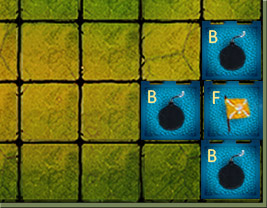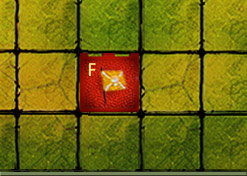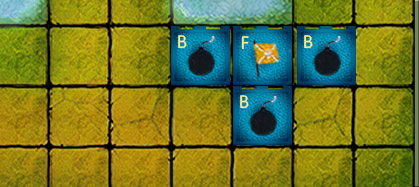
By Seth Brown.
The Corner

PRO: The corner flag placement has a few things to recommend it. Most obviously, your flag in the corner can only be approached from two sides, as opposed to three or four. The flag is thus very easy to defend without needing many of your bombs or power pieces, by occupying the two spaces adjacent to the corner space.
Unless the enemy eliminates most of your back row, your corner flag is only vulnerable to a direct frontal assault, so it is easy to stack powerful defense there.
And finally, if your opponent happens to focus forces on the wrong side of the board, your flag will be safe for a while.
CON: The corner flag placement is probably the most common flag placement in all of Stratego, for the reasons listed above. And the problem with this is that if your opponent has played Stratego before, you may be facing down a focused assault on your corners. A low number and a miner to defuse bombs can make quick work of your edge columns.
- Conclussion: The corner is a good place for your flag. But don't put it there more than half the time, or you will be predictable and easily defeated.
Up the Side

PRO: Not predictable like a back row placement. Your opponent certainly won't expect your flag to be on the edge of the second or third row.
CON: All the negatives of corner placement, but worse. If your opponent expects a corner flag placement, you'll still be facing an edge assault. Having your flag further up in this case just means your opponent will find it sooner on a march down to the corner.
- Conclussion: Avoid this flag placement; the only reason it's unexpected is because it's a terrible idea.
Middling Back Row

PRO: Flag is only vulnerable from three sides, instead of four. You can still defend this without expending too many of your power pieces. Opponents will have to fight through three rows of your defense to reach the flag. And due to the flag's placement towards the center, you can pull in additional defenders from either side.
CON: The center of the board is the most natural place for an enemy attack. Forces from either side can be brought to bear after advancing up the left or right flank, in addition to the initial forward movement in the center. But this is a small drawback.
- Conclussion: Another good flag placement, but like the corner, be sure not to use this more than half the time, or you will be too predictable.
Middle of the Muddle

PRO: Unexpected. Most Stratego players hide their flag somewhere in the back row, whether in a corner or not. By putting your flag in the second or third row, you may be able to avoid the ill effects of a back-row sweep. In addition, not having a flag anywhere expected will allow you to set up decoy flagposts to lure in your opponent.
CON: Four sides of vulnerability mean that you're going to use either a lot of power pieces or a lot of bombs trying to defend this. In addition, pieces in the center often start to move very quickly once the game begins, so if yours don't (because they are flags and bombs) it may look suspicious.
- Conclussion: A reasonable occasional strategy to throw off your opponent.
Front Row Blocked

PRO: Often overlooked, the four spaces behind the impassable river squares make an interesting choice to hide a flag. Opponents rarely bother clearing your entire front row, since flags are almost always further back and defended. This means that most assaults will continue down one of the six open columns, leaving your flag in the front row untouched. This placement likewise leaves you plenty of space to defend decoy flagposts.
CON: If the opponent happens to move sideways in that top row, you are going to lose.
- Conclussion: A risky play, should only be used rarely, ideally after a few games of corner placement. Front Row Open.
Check also this detailed information about: Bomb Placement
Continue Reading


